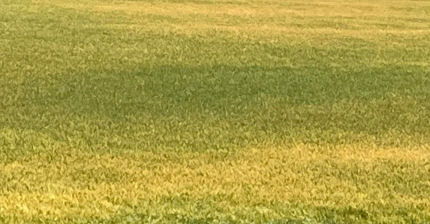“Continuous wheat and fallow wheat are two different crops.”
That statement was made at a resolutions session of the Kansas Association of Wheat Growers (KAWG) last fall from northwest Kansas wheat farmer Chris Tanner, who serves as KAWG vice president. As two different crops, they should be able to be insured separately, he said.
“Farmers currently don’t have the option to insure wheat enterprise units by fallow and continuous separately and must combine them,” said Tanner. “Fallow APH and continuous APH are reported separately but blended for crop insurance purposes.”
This sentiment was never more evident than when Tanner’s wheat was threatened by hail, once again, this week.
Even with the multiyear drought and rains during harvest, Tanner’s fallow wheat was yielding about 70 bushels per acre, compared with his wheat after corn that was yielding only 20 to 40 bushels per acre. Wheat in northwest Kansas was fortunate this year, benefiting from the early summer rains because of its later development than wheat in other parts of the state.
At the fall resolutions session, KAWG voted to add a resolution stating, “The KAWG supports efforts to improve crop insurance performance for farmers through the separation of enterprise units by fallow and continuous, while still offering combined units to those who it would benefit.” This resolution was then approved by the full KAWG membership in January 2023 and presented to the National Association of Wheat Growers in March.
Then last month, U.S. Senators Roger Marshall, M.D. (R-KS) and Michael Bennet (D-CO) introduced legislation that will allow farmers to insure wheat enterprise units by fallow and continuous, while still offering a combined option for those who it would benefit. This is similar to the 2014 Farm Bill provision providing for separate enterprise units for irrigated and non-irrigated acreage of crops.
KAWG commends the bipartisan efforts of Marshall and Bennet to work on behalf of farmers to improve the safety net in the upcoming Farm Bill.
KAWG president Kyler Millershaski said, “Making the change to be able to separate the two cropping styles would be a great benefit to wheat farmers by allowing them to protect their crops and operations effectively, giving them more confidence in their business decisions, and bringing an important tool (crop insurance) up to date with modern farming practices.”
For now, Tanner’s good fallow wheat is safely in the bin and harvest continues on the lower-yielding wheat after corn. Millershaski isn’t as lucky, since this year’s delayed harvest has yet to begin on his farm in southwest Kansas. Even so, harvest won’t last long once it gets going, as his family will only be able to harvest about 10 percent of last fall’s planted acres. The other 90 percent were already lost to the drought.
Even while in the combine cab, Millershaski, Tanner and others are working on behalf of all Kansas farmers for the betterment of the industry. To bring up other issues that would benefit Kansas farmers or to become a KAWG member, contact [email protected].



